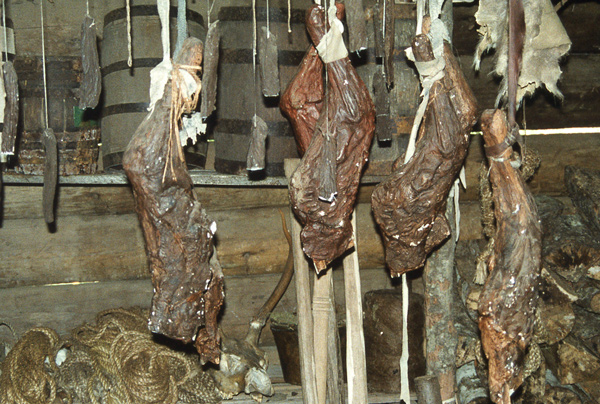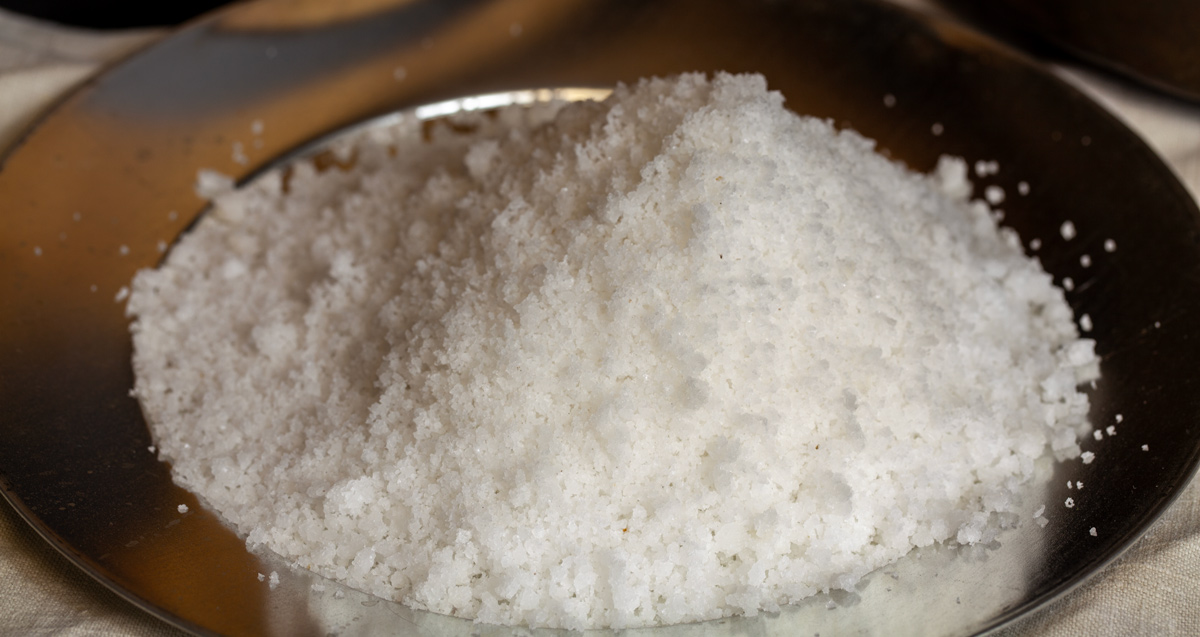Drying Meat
Fort Clatsop (replica)

Taken in cooperation with Fort Clatsop National Historic Park, U.S. National Park Service. Photo © 1995 by Kristopher K. Townsend. Permission to use granted under the Creative Commons Attribution-Share Alike 4.0 International license.
Beyond the daily dietary needs of 33 persons, salt served functions that were equally as important as drying meat—namely, tanning hides for clothing and moccasins. One more way of dehydrating the meat was available once it was in the smokehouse: Rubbing the flitches and fleeces with salt would quickly draw moisture to the surface where it could evaporate. At that rate, a gallon would not last very long, and the first significant if still marginally sufficient supply didn’t arrive from the seaside salt works until the third of February. Lewis summarized the situation:
late in the evening the four men who had been sent to assist the salt makers in transporting meat which they had killed to their camp, . . . returned, and brought with them all the salt which had been made, consisting of about one busshel only. with the means we have of boiling the salt water we find it a very tedious opperation . . . notwithstanding we keep the kettles boiling day and night. we calculate on three bushels lasting us from hence to our deposits of that article on the Missouri.[1]Conceivably they had bought more salt in Saint Louis (Moulton, Journals, 4 May 1804), and had chosen to deposit some in a cache (they spelled the French term as they heard it pronounced: … Continue reading
Brink of Starvation
Sea Salt
©2012 by Kristopher K. Townsend. Permission to use granted under the Creative Commons Attribution-Share Alike 4.0 International license.
Above: This salt was made by boiling ocean water from the original The Salt Works location (Seaside, Oregon) in late December.
Ultimately, that calculation wouldn’t work out, partly because of the unexpected month-long delay in starting across the snowpacked Bitterroot Mountains. For as long as they expected to remain at Fort Clatsop, they could only hope that, smokey or not, hot air would carry the humidity toward the ceiling and out. But for optimum drying speed the humidity in the smokehouse needed to be below 30%, whereas the average relative humidity outdoors during the months of November and December was probably close to 70 or 80% or higher.[2]A cold spell began on 25 January 1806 with a half-inch overnight snowfall, and lasted until 7 February 1806, descending well below freezing twice. On the morning of 27 January 1806 the snow was six … Continue reading It seemed as if the men of the Corps, as well as Sacagawea and little Jean Baptiste Charbonneau, would have to choke down rancid elk meat during the coming holidays, and on through the dreary weeks of January, February and March before they could depart for drier climes.
They had teetered at the brink of despond before, as in those hungry days toward the end of their treck through the Bitterroots. But then, while their bodies grew “pore” from lack of food, their hopes were nourished by the fact that as the days went by they could see new signs of an end to their misery. At least they were moving downhill toward good hunting, nourishment, and rest. But here at latitude 46°11’20″N, only about one degree (69 miles) south of Fort Mandan’s wintry snow, ice, and frigid winds at Latitude 47°17’29″N, they were trapped in almost incessant rain and high humidity, within a narrow range of comparatively moderate temperatures. While the captains had urgent work to do—reports to write and maps to draw—their men were either hunting, rushing dead meat back to camp before it got too rotten to eat, cutting and splitting firewood, or curing deer and elk hides and fashioning desperately needed leather clothing and moccasins. They began tackling that last problem immediately after their rooms were roofed and the log walls chinked to keep out the chilling wind.
Salt-curing Meat
On 5 January 1806 the salt makers, Joseph Field, William Bratton and George Gibson, having found that “they could obtain from 3 quarts to a gallon a day,” proudly brought to the fort about a gallon of salt, “excellent, fine, strong, & white,” which was, said Lewis, “a great treat to myself and most of the party,” not having had any since the 20 December 1805.
It was wintertime on the northwest coast, and the weather was typically wet and chilly, although seldom below freezing—ideal for the propagation of bacteria that cause meat to spoil. The elk the hunters shot was often tainted before they could get it back to the fort, and was, Clark complained on 29 December 1805, “extreamly disagreeable to the Smel. as well as the taste.”
Back on the plains east of the Rockies, the best recourse had been to “jerk” or “fleece” the fresh meat they didn’t eat right away. That solution was problematic at Fort Clatsop. “We have yet seen no ice,” the captains remarked on 3 January 1806, “and the weather so warm that we are obliged cure our meat with smoke and fire to save it. …we lost two parsels by depending on the air to preserve it, tho’ it was cut in very thin slices and sufficiently exposed to the air.”
It’s no wonder. Bacteria multiply quickly in meat at or above 40 degrees Fahrenheit. We don’t know what temperatures were like that winter, because their last thermometer had been broken early the preceding September. We do know that between 1961 and 1990 the average daily temperature ranged from a low of 18.3 degrees to a high of 43.4 degrees Fahrenheit. Bacteria also thrive in a moist habitat, and although they couldn’t measure humidity in the field (the hygrometer would be invented in 1820 by Englishman John Daniell), they knew it was high. “We have not been able to keep anything dry for many days together since we arrived in this neighbourhood,” Lewis wrote on January 6, “the humidity of the air has been so excessively great.” In fact, today the daily average ranges between 70 and 90 percent saturation from November through March.
Running Out
Salt, however, liberally massaged into meat, draws moisture to itself; the meat “perspires” and the bacteria die of thirst. The captains allotted eight of the 28 gallons the saltmakers refined for use during the rest of the winter, which should have been sufficient to preserve hundreds of pounds of meat. Yet by late February they had “three days provisions only in store and that of the most inferior dryed Elk a little tainted.” It was, Lewis continued sarcastically, “a comfortable prospect for good living.”
One reason could have been that the elk had moved too far south and east into the mountains, to get it to the Fort’s meat house before it spoiled. Another is that they might have used a large amount of their salt supply to cure hides for clothing and moccasins. Of course, if one could scrape a hide quickly enough and air-dry it thoroughly enough—the latter an unlikely prospect at Fort Clatsop—salting wouldn’t have been necessary. In any event, something worked in the long run. Sergeant Patrick Gass noted on 13 March 1806, ten days before they started for home, that they had made a total of 338 pairs of moccasins, plus a “sufficient quantitity of patch-leather” for each man. We’re never told how they managed to cover the rest of their bodies, which apparently they did.
On 20 March 1806, Lewis optimistically reported “our salt will be very sufficient to last us to the Missouri where we have a stock in store.” But it didn’t. They were saltless again by the twentieth of June, except for two quarts that Lewis held in reserve for his anticipated trip up the Marias River, but they still had to make that strenuous trip back across the Bitterroot Mountains, and even in cold weather they would perspire heavily, and their bodies would crave salt.
Notes
| ↑1 | Conceivably they had bought more salt in Saint Louis (Moulton, Journals, 4 May 1804), and had chosen to deposit some in a cache (they spelled the French term as they heard it pronounced: “cash”) that they dug at the mouth of the Marias River, and at one of the other caches where they had deposited excess baggage, above and below the Great Falls of the Missouri and at “Camp Fortunate.” |
|---|---|
| ↑2 | A cold spell began on 25 January 1806 with a half-inch overnight snowfall, and lasted until 7 February 1806, descending well below freezing twice. On the morning of 27 January 1806 the snow was six inches deep, and 18-inch icicles hung from the eaves. The third and last of their thermometers having been broken back on 4 September 1805, Lewis could only estimate the temperature on the morning of the 28th. He guessed it was about 15° above zero. After a temporary break in the weather the spell peaked again on 6 February 1806, when Lewis figured it was the coldest yet. By the morning of the 8th, however, he felt that “the rigor of the winter” had passed. In fact, it was so warm that he was afraid all their meat would spoil, so they hurried to cut it into smaller pieces and hang them separately on sticks in the smokehouse. |

